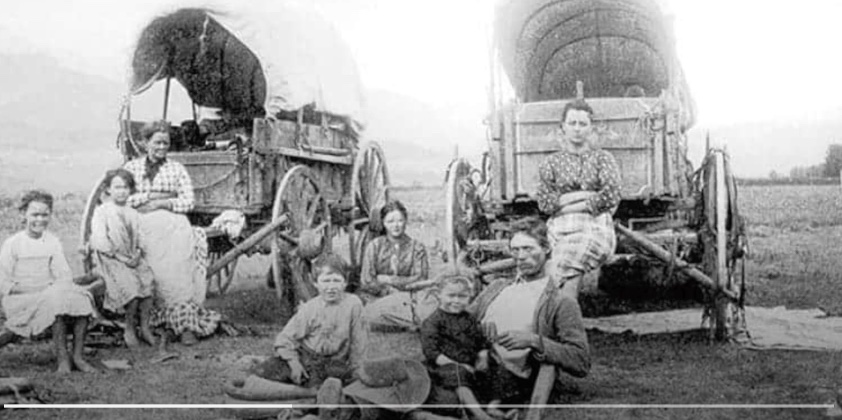Welcome to Episode 110 of Ramping Up your English!




Watching Episode 110
Pressure from the United States in seeking more land for settlement caused deep divisions within many Native American tribes, just as the United States itself was being divided over the issue of African Chattel Slavery. Watch Episode 110: Divided without ads by clicking here. You can also download the video from this site.
Episode Summary
Just as the United States was divided in the way it saw Native Americans, pressure from settlers and conflict with the U.S. Army divided Indian tribes, bands, and even families. The Oregon Trail brought much of that pressure to Native Americans living West of the Mississippi River. The California Gold Rush swelled the number of Emigrants from the United States, causing desperation nd poverty for Indigenous Americans in these regions.
We meet the Cheyenne in this episode. Like many who had lived further East, The Cheyenne were pushed west and became a major force on the Great Plains. The Cheyenne hunted bison wont the plains and traded with other groups. They befriended the Lakota Sioux, only to be pushed out of the Black Hills by them. The Cheyenne expanded in to the Southern Plains without dividing as a group.
The Southern Plains saw the entrance of the Comanche, who displaced most of the Apache who had dominated large parts of Texas. The Apache remained friends and trading partners of the Pueblo, until Spanish missions dominated Pueblo labor. The Apache then raided the Pueblo as well as others. When the United States went to war with Mexico, they found themselves allied in their fight against that country. This made for good relations between the Apache and the United States.
The victory of Texas over Mexico’s Santa Ana gave birth to the Lone Star Republic. The Texas Republic no longer allowed Native Americans who had found refuge from removal to stay. They had been seen as a buffer between settlers and Comanches, but they were no longer seen as needed. Texas independence was followed by the War with Mexico. The United States came out of this war victorious, and Spanish-speaking communities saw the border move, making them part of the United States. Now they suffered discrimination from the government and raids by Native Americans.
The Pawnees were also featured in this episode. The Pawnees found themselves surrounded by enemies, including tribes who had been removed from the East. Further west, the Crow found themselves in a similar situation. Both groups sought good relations with the United States as a source of protection from their hostile neighbors.
The Cayuse War opened violence throughout the Pacific Northwest. The unrest that resulted included the U.S. Army, but the major attention was on winning the Civil War. During that war, the Sioux population in Minnesota suffered from blatant corruption that left many of them starving. Sioux warriors attacked farms, killing hundreds of settlers. This rebellion was put down quickly, and 38 of the combatants were later hung. The surviving Sioux were cut off from all government support and the reservation was dissolved. Most left Minnesota to live with other Sioux bands.
Language Objectives
Use past-tense verbs to relate the events that caused division within Native American communities.
Use conjunctions to relate cause/effect relationships that resulted in changes that affected Native Americans.
Use conjunctions to relate causes and effects of the War With Mexico.
Describe the geographic changes resulting from the War With Mexico.
Describe the relationship between the Apaches and the United States when War with Mexico broke out.
Characterize the situation that the Pawnee and the Crow had that led to friendly relations with the United States.
Characterize the violence that occurred in Minnesota during the uprising of the Sioux loving on the reservation there.
Academic Content Objectives
Describe the difference between attitudes about Native Americas between Americans who lived in the East and those who lived on the western frontier.
Trace the replacement by Comanches of the Apaches in Texas.
Explain the role that horses played in the accent of the Comanches.
List Native American groups that moved onto the Great Plains.
Characterize the importance of Bison to Greate Plains groups.
Trace the success of the Cheyenne as they moved not the Great Plains.
Describe the Fort Laramie Treat of 1851 as it relates to the Cheyenne and the Oregon Trail.
Give examples of ways that emigrants of the OregonTrail caused problems for indigenous Americans living along the trail.
Describe the role of European diseases on Native Americans in the West.
Give examples of how the independence of Texas and the War With Mexico affected Native Americans who had sought refuge there during the Indian Removal.
Characterize the rise of Comanches on the Southern Plains.
Characterize the situation that the Pawnee and the Crow had in common, and how they sought to overcome this situation.
Trace the causes of the Cause War and the spread of violence that resulted from that war,
Relate the causes and effects of the Minnesota uprising.
Videos Used in Episode 110
The video featured in this episode is number 20 in the Native American series. Watch the video ad-free by clicking here.
For a longer version of this video – with more detail and before final editing – click here.
Links to Related Videos
While the Oregon Train migrations were devastating to many Natuve Americans, the Great Migration is celebrated by non-Indian Americans. Click here for a video of a re-enactment of the Oregon Trail.
For the video Little Crow and the Dakota War, Click Here.
Click here for al longer version.
The 1862 Minnesota Massacre is just another name for the same war. Click here to watch the video.
The National Archives produced a video entitled The Choctaw Confederates. Click here to learn about the Choctaw’s alliance with the South.
Next Episode
Learn all about the mythical west in our next Episode. Click here to visit the Episode 111 page.